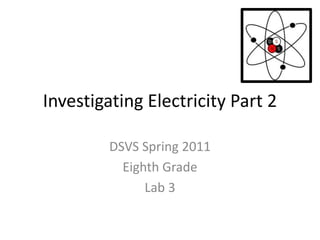
Investigating electricity part 2
- 1. Investigating Electricity Part 2 DSVS Spring 2011 Eighth Grade Lab 3
- 2. Lab Set Up These labs primarily consist of measuring current in different portions of circuits using an ammeter. If you’re short on time, I’d suggest skipping either 6 or 7 (but not both). If you find the photos confusing, there are circuit diagrams in the student handouts. The circuits suggested require more wires than the kit provides. You can solve this by removing a battery in most cases. Part 10 is the most fun. Make an effort to get to this lab, even if you just demonstrate if for them.
- 3. 6: Measuring the Current in a Series Circuit Have the students connect the circuit shown. They will then connect the ammeter at different locations and record their observations.
- 4. 7: Measuring the Current in a Parallel Circuit Have the students connect the circuit shown. They will then connect the ammeter at different locations and record their observations.
- 5. 8: The Effect of Resistance in a Circuit Explain to the students that bulbs act as resistance to the current Connect the circuits shown. What is the relationship between resistance and current?
- 6. 9: Variable Resistance in a Circuit First you have to make the variable resistor. Coil wire around another object like a pencil or a nail
- 7. 9: Variable Resistance in a Circuit Connect the circuit as shown. The bulbs will probably not light.
- 8. 9: Variable Resistance in a Circuit Vary the resistance by changing the connection point to the resistor. At this point the bulbs should light. Q: What happens to the current in the circuit when you move the lead back and forth? A: The current varies between its max and min.
- 9. 10: How a Fuse Works Connect the circuit shown. Connect a wire across the bulb. Q: What happens when a short circuit is made? A: The bulb goes out. The connection is made with a few twisted stands of steel wool. The steel wool has to be very thin for this to work.
- 10. 10: How a Fuse Works Modify the circuit by completing the connection with a few twisted strands of steel wool. The steel wool has to be very thin for this to work The steel wool acts as a fuse.
- 11. 10: How a Fuse Works Short out the circuit again. The steel wool will burn up. Instruct students to be careful and supervise well during this part of the lab. You may also wish to just demonstrate. Q: Why does the fuse melt? A: The fuse melts because the current is large and there is almost no resistance in the circuit. The fuse becomes hot and melts. Q: Why do you need a fuse in a circuit? A: The fuse protects the circuit. If the fuse did not melt, a short circuit could cause the wires in the circuit itself to melt and possibly start a fire.
- 12. 10: How a Fuse Works
- 13. Wrapping it Up Clean up. Answer student questions Conclude the lab, discussing the experiments performed. Say goodbye to the students, tell them how much you enjoyed working with them.
- 14. References These activities and discussion questions are from: “Investigating Electricity” Hubbard Scientific Inc. Chippewa Falls, Wisconsin Training slides and photos Lerin Rutherford